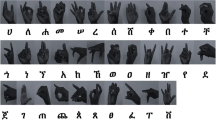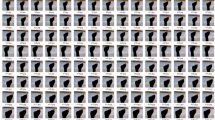Abstract
Sign language is the natural way of communication of speech and hearing-impaired people. Using Indian Sign Language (ISL) interpretation system, hearing impaired people may interact with normal people with the help of Human Computer Interaction (HCI). This paper presents a method for automatic recognition of two-handed signs of Indian Sign language (ISL). The three phases of this work include preprocessing, feature extraction and classification. We trained a BPN with Histogram Oriented Gradient (HOG) features. The trained model is used for testing the real time gestures. The overall accuracy achieved was 89.5% with 5184 input features and 50 hidden neurons. A deep learning approach was also implemented using AlexNet, GoogleNet, VGG-16 and VGG-19 which gave accuracies of 99.11%, 95.84%, 98.42% and 99.11% respectively. MATLAB is used as the simulation platform. The proposed technology is used as a teaching assistant for specially abled persons and has demonstrated an increase in cognitive ability of 60–70% in children. This system demonstrates image processing and machine learning approaches to recognize alphabets from the Indian sign language, which can be used as an ICT (information and communication technology) tool to enhance their cognitive capability.


















Similar content being viewed by others
References
Abubakar, F. M. (2012). Image enhancement using histogram equalization and spatial filtering. International Journal of Science and Research (IJSR), 1(3), 105–107.
Athira, P. K., Sruthi, C. J., & Lijiya, A. (2019). A signer independent sign language recognition with co-articulation elimination from live videos: an Indian scenario. Journal of King Saud University-Computer and Information Sciences.
Balbin, J. R., Padilla, D. A., Caluyo, F. S., Fausto, J. C., Hortinela, C. C., Manlises, C. O., … & Ventura, L. T. (2016). Sign language word translator using neural networks for the aurally impaired as a tool for communication. In 2016 6th IEEE International Conference on Control System, Computing and Engineering (ICCSCE) (pp. 425–429). IEEE.
Bhame, V., Sreemathy, R., & Dhumal, H. (2014). Vision based hand gesture recognition using eccentric approach for human computer interaction. In 2014 International Conference on Advances in Computing, Communications and Informatics (ICACCI) (pp. 949–953). IEEE.
Diaz, C. A. M., Castaneda, E. E. M., & Vassallo, C. A. M. (2019). Deep learning for plant classification in precision agriculture. In 2019 International Conference on Computer, Control, Informatics and its Applications (IC3INA) (pp. 9–13). IEEE.
Dutta, K. K., & GS, A. K. (2015). Double handed Indian Sign Language to speech and text. In 2015 Third International Conference on Image Information Processing (ICIIP) (pp. 374–377). IEEE.
Ghani, F. (2004). Improved 2-D median filter for on-line impulse noise suppression. In IEEE Region 10 Conference.
Konwar, A. S., Borah, B. S., & Tuithung, C. T. (2014). An American sign language detection system using HSV color model and edge detection. In 2014 International Conference on Communication and Signal Processing (pp. 743–747). IEEE.
Kothadiya, D., Bhatt, C., Sapariya, K., Patel, K., Gil-González, A. B., & Corchado, J. M. (2022). Deepsign: Sign language detection and recognition using deep learning. Electronics, 11(11), 1780.
Kurhekar, P., Phadtare, J., Sinha, S., & Shirsat, K. P. (2019). Real time sign language estimation system. In 2019 3rd International Conference on Trends in Electronics and Informatics (ICOEI) (pp. 654–658). IEEE.
Nimisha, K. P., & Jacob, A. (2020). A brief review of the recent trends in sign language recognition. In 2020 International Conference on Communication and Signal Processing (ICCSP) (pp. 186–190). IEEE.
Papastratis, I., Chatzikonstantinou, C., Konstantinidis, D., Dimitropoulos, K., & Daras, P. (2021). Artificial intelligence technologies for sign language. Sensors, 21(17), 5843.
Raheja, J. L., Mishra, A., & Chaudhary, A. (2016). Indian sign language recognition using SVM. Pattern Recognition and Image Analysis, 26(2), 434–441.
Rao, G. A., & Kishore, P. V. V. (2018). Selfie video based continuous Indian sign language recognition system. Ain Shams Engineering Journal, 9(4), 1929–1939.
Sahoo, A. K., & Ravulakollu, K. K. (2014). Indian sign language recognition using skin color detection. International Journal of Applied Engineering Research (IJAER), 9(20), 7347–7360.
Sarkaleh, A. K., Poorahangaryan, F., Zanj, B., & Karami, A. (2009). A Neural Network based system for Persian sign language recognition. In 2009 IEEE International Conference on Signal and Image Processing Applications (pp. 145–149). IEEE.
Saxena, A., Jain, D. K., & Singhal, A. (2014). Sign language recognition using principal component analysis. In 2014 Fourth International Conference on Communication Systems and Network Technologies (pp. 810-813). IEEE.
Shuhua, L., & Gaizhi, G. (2010). The application of improved HSV color space model in image processing. In 2010 2nd International Conference on Future Computer and Communication (Vol. 2, pp. V2–10). IEEE.
Singh, R. P., & Dixit, M. (2015). Histogram equalization: A strong technique for image enhancement. International Journal of Signal Processing, Image Processing and Pattern Recognition, 8(8), 345–352.
Sridhar, A., Ganesan, R. G., Kumar, P., & Khapra, M. (2020). Include: A large scale dataset for indian sign language recognition. In Proceedings of the 28th ACM international conference on multimedia (pp. 1366–1375).
Stergiopoulou, E., & Papamarkos, N. (2009). Hand gesture recognition using a neural network shape fitting technique. Engineering Applications of Artificial Intelligence, 22(8), 1141–1158.
Sural, S., Qian, G., & Pramanik, S. (2002). Segmentation and histogram generation using the HSV color space for image retrieval. In Proceedings. International Conference on Image Processing (Vol. 2, pp. II-II). IEEE.
Verma, V. K., Srivastava, S., & Kumar, N. (2015). A comprehensive review on automation of Indian sign language. In 2015 International Conference on Advances in Computer Engineering and Applications (pp. 138-142). IEEE
Acknowledgements
We thank Rajiv Gandhi science & Technology Commission, Government of Maharashtra, INDIA for funding this work. We also acknowledge the support provided by Pune Institute of Computer Technology, INDIA.
Author information
Authors and Affiliations
Corresponding author
Ethics declarations
Conflict of interest
The authors declare that they have no conflict of interest.
Additional information
Publisher's note
Springer Nature remains neutral with regard to jurisdictional claims in published maps and institutional affiliations.
Rights and permissions
Springer Nature or its licensor holds exclusive rights to this article under a publishing agreement with the author(s) or other rightsholder(s); author self-archiving of the accepted manuscript version of this article is solely governed by the terms of such publishing agreement and applicable law.
About this article
Cite this article
Sreemathy, R., Turuk, M., Kulkarni, I. et al. Sign language recognition using artificial intelligence. Educ Inf Technol 28, 5259–5278 (2023). https://doi.org/10.1007/s10639-022-11391-z
Received:
Accepted:
Published:
Issue Date:
DOI: https://doi.org/10.1007/s10639-022-11391-z




